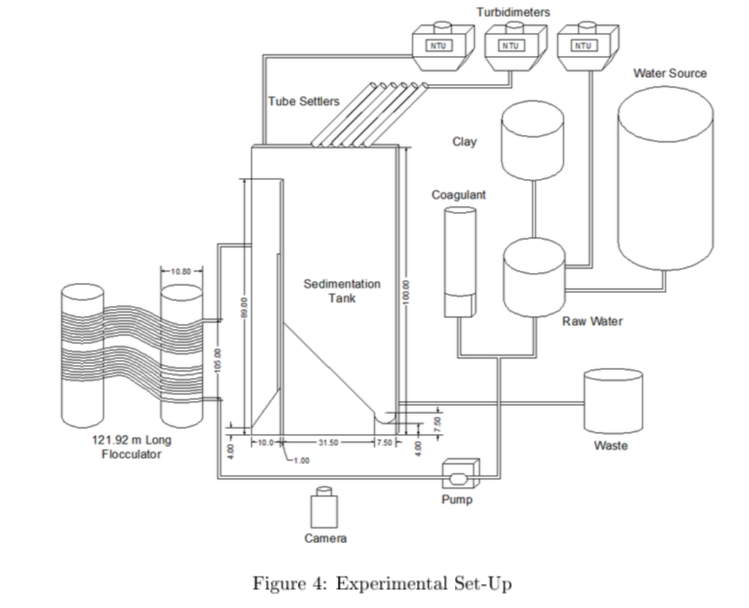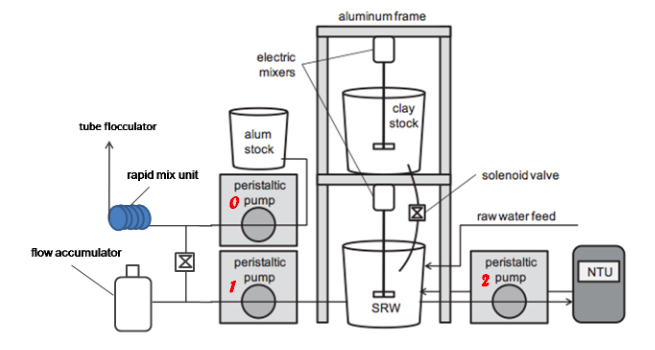Frances Ciolino, Andrea Fortman, Marlana Hinkley, Marlon Passos
Chemical Dose Controller - Spring 2013
Andrea Castro, Kent Chan, Saugat Ghimire
Abstract:
Accurate chemical dosing is an essential part of an AguaClara plant. Proper dosing is required for effective flocculation, sedimentation, filtration and disinfection. Coagulant (Poly Aluminum Chloride or Alum) and disinfectant (Chlorine) are chemicals used for dosing in an AguaClara plant. The linear chemical dose controller (LCDC) automatically maintains a linear relationship between the influent flow to the plant and the chemical dose. The plant operator therefore only adjusts the dose of coagulant based on the turbidity of the influent water. The Spring 2013 team has had two lever-arm assemblies fabricated by Hancock Precision based on the Fall 2012 design with additional improvements, such as having one end rod of the lever arm made up entirely of stainless steel instead of having a stainless steel rod placed over the aluminum rod and substituting anodization of the lever arm with powder coating, as the latter is more resistant to a corrosive environment. One unit has been sent to Honduras and the other is expected to be utilized in India. In addition to this, we have fabricated the manifold system out of PVC, a chemical resistant material. Through application of the orifice equation, we sized the constant head tank float valve orifice. Through application of a statics equation we determined that the oat valve size could be reduced, allowing the use of a standard 5-gallon bucket for the constant head tank. We fabricated a constant head tank, suspended by a chain and attached to a turnbuckle, which can be easily adjusted during calibration. We have set up a fully functional unit of the coagulant dosing component of the dose controller in the lab, calibrated the unit, and tested the system at our maximum flow rate to compare how the system behaves compared to the model prediction and were below ten percent error. We created a detailed 3-D drawing in Google SketchUp of the current design of the linear chemical doser system including all appurtenances, in addition to creating a parts list, to facilitate future fabrications and assembly. This will not only be helpful for future groups to better understand the dose controller but also make it easier for the manufacturers to build it in the future. We also came up with ideas for protecting the entrance tank oats as water enters the plants at some locations in Honduras, to reduce dosing error.
Laminar Tube Flocculator - Spring 2013
Margaret L. Fleming, Patience Ruijia L
Full Scale Floc Breakup - Spring 2013
David Buck and Meg Fitzgerald
Abstract:
The objective of this research was to design a floc break up device to test the concept of floc break up at full-scale and improve flocculation performance of the AguaClara plant located in Atima, Honduras. Recent research suggests that using ow constrictions to break up flocs improves performance and reduces settled water turbidity. Using this hypothesis, we designed a device to cause floc break up. We used a perforated plastic sheet which constricts ow and creates many jets, which dissipate energy and break flocs. The proposed design for the prototype for Atima includes 21 orifices and an orifice diameter of 5.1 cm (2), which results in approximately 9.3 mm of head loss per device and 40% open area. We also determined that the devices should be optimally placed in the flocculator so that water flows upward through them. We plan to attach the devices between the baffles and walls of the flocculator with foam blocks. Our design can be fabricated in Honduras with locally sourced materials, so although the fabrication will require local labor, it does not rely on shipping materials from the United States. We will send our design to Drew Hart in Honduras who will fabricate the perforated plates and test them at full scale.
Foam Filtration - Spring 2013
Jenny Guan, Monica Kuroki, Lishan Zhu
Abstract:
Originally, the foam filtration system was designed to provide clean water to small-scale communities. The system was also designed to provide water in emergency situations such as a refugee camps. The system was ideally powered by gravity and the optimal filtration rate was made to be 3 L/min. For the Spring 2013 semester, the foam filtration team began fabricating a new system and recording the process of the new system. The previous filtration system was designed and shipped to Honduras in January 2013. The current design focuses on pieces readily acquired in-country. This allows feasible construction in Honduras and, potentially, other developing countries. Products such as 8020 steel, clear PVC piping and flexible tubing have been removed from the design because they cannot be easily found outside of the US. The foam filtration team this semester is also working on making the design more compact for easy transportation. Additionally, the foam filtration team designed a new compact stand of PVC piping to hold the filtration system. The team included a larger collection tank to allow for the incorporation of a linear dosing system.
Calcium Carbonate Scaling, Spring 2013
David Buck and Andrea Castro
Abstract
The municipality of Las Vegas, Honduras is currently experiencing a decrease in the capacity of their water distribution network due to the accumulation of scale in pipes. Our hypothesis is that this is caused by the karst topography of the region. The water source for Las Vegas is a groundwater spring. Groundwater, initially at a low temperature, flows across sediments containing calcium carbonate, CaCO3(s) . The water heats up when it reaches the surface and as it flows through shallow pipes to the end of the distribution system. As the water warms and reaches equilibrium at a new temperature, calcium carbonate precipitates, coating the pipes in a hard scale. An AguaClara plant could solve this problem by dosing acid, which would drop the pH and prevent the formation of scale by keeping calcium in aqueous form. The purpose of the present analysis is to determine how much acid in the form of aluminum sulfate, Al2 (SO4) 3 , should be added and provide further analysis giving evidence for the present solution.
Coagulant Management, Spring 2013
Madeline Haas, Rudra Koul, Jack Newman
Abstract
Coagulants are an essential part of a water filtration plant as well as a signifiant operating cost. Therefore, it is very important that they be used as effiently as possible. This semester, the Coagulant Management team has calculated and analyzed the relationship between PACl density and concentration that was ultimately used in calculations necessary for centrifugal pump parameters and for hydrometer recommendations. In addition, the team brainstormed fabrication ideas for the coagulant injection point. The centrifugal pump was partially fabricated, but because of the density vs. concentration relationship calculated, the pump, once fully fabricated, can be tested using PACl. In addition, the Coagulant Management team has recommended the testing and use of a plastic (polycarbonate) hydrometer from Krackeler Scientific Inc. with a specific gravity range between 1.000 and 1.220.
Demo Plant, Spring 2013
Eric Stucker and Jen Weidman
Abstract
The demo plant team is responsible for design, construction, and troubleshooting of the AguaClara Demo Plant. The successful operation of this plant is crucial in order to demonstrate the inner workings of AguaClara plants to students, faculty, staff, community members, business partners, and potential sponsors. This spring semester, our research team has focused on creating one complete demo plant, and fixing issues with that plant, such as an unreliable flocculator and concerns with differences in head. This work included implementing and testing new fittings for the stacked rapid sand filter, conceptualizing and implementing a more efficient way to facilitate plant assembly and startup to those unfamiliar with it, resolving issues with improper coagulant dosing and head loss differences, and properly documenting all aspects of the plant so that future team members new to AguaClara (like us) would have much less difficulty familiarizing themselves with the Demo Plant.We also measured and adjusted plant ow rates to match historical data and ensure smoother operation of the plant, and labeled tanks to further improve ease of operation of the plant. While we did not achieve our goal of fabricating new plants for future teams to use, we documented all the materials present, as well as those we need, and we provided detailed drawings for future construction.








